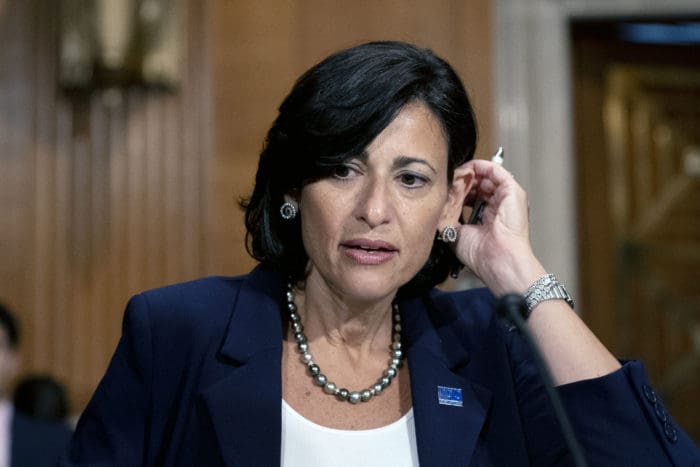Last week, the director of the U.S. Centers for Disease Control and Prevention (CDC), Dr. Rochelle Walensky, announced the CDC’s new public-health focus—addressing the Biden Administration’s newly labeled “gun violence public health epidemic.”
Given the CDC’s handling of the COVID-19 pandemic and its unconstitutional eviction moratorium (that the Supreme Court recently struck down) Americans have good reason to be skeptical. Anticipating such skepticism, Dr. Walensky told CNN in an exclusive interview: “My job is to understand and evaluate the problem.”
But that isn’t her job at all.
“I’m not here about gun control,” she assured. “I’m here about preventing gun violence and gun death.”
But those terms are, in and of themselves, part of the gun control agenda. Several things stand out in this piece of soft-totalitarian propaganda.
First and foremost, there is the language of “gun violence.”
“Gun violence” strikes many people as nothing more than the description of a crime—like “mail fraud” or “car theft.” It’s now so common in the media that plenty of Americans say the words without even thinking.
But the term “gun violence” is used to blame guns for crime—to demonize them—and to advance gun control. Outlets like CNN, MSNBC, and NPR have used the phrase tens of thousands of times in what is now clearly a form of deliberate political messaging.
The truth is guns don’t cause crime, and guns don’t commit “violence.”
Acts of violent aggression are choices carried out by human beings who have abandoned all considerations of human life and are intent upon harming people. They alone are responsible for their choices.
The same disturbing dismissal of personal responsibility is at work when the terms “public health” and “epidemic” are used to discuss guns and violence.
In this rhetorical setup, individual acts of violence are not really the issue; what media and gun control activists claim matters is that society is suffering from a “gun violence epidemic.” (Our word “epidemic” is from the Ancient Greek epi and demos—signifying something that has “come upon the whole people.”)
This language of an “epidemic” is meant to make us think about the problem, and thus the “solution,” in collective terms—as if violence was not a choice on the part of individuals but a general condition of public life. They cast it as a universal problem, calling for a universal solution.
Dr. Walensky even makes reference to “40,000 related deaths” and “120,000 serious injuries” every year. Conspicuously absent is any discussion of the “60,000 to 2.5 million defensive gun uses each year.” A data point Dr. Walensky should be intimately familiar with since it comes from the CDC.
Then there is the term “public health.” Who could possibly be opposed to health?
To define “gun violence” as a “public health” issue poisons the well for any possible discussion. It attacks the opponent’s morality by the way the proponent frames the purported problem: I am for addressing the gun violence public health epidemic; my opponent opposes life-saving public health measures.
In addition to serving as an effective rhetorical device, defining a problem as a “public health epidemic” is also a convenient way of securing taxpayer dollars for pseudo-medical studies and bureaucratic projects that waste our money on partisan political advocacy. And, of course, those studies often conveniently come to a conclusion most useful to whatever politician or bureaucrat ordered the study.
In matters of language and in matters of law, what begins with gun control will not end there. In the future, we will see more political questions defined in these kinds of terms—as “epidemic” or “systemic,” and as “public health” issues. It is convenient messaging for utopian-minded social engineers and designed specifically to be appealing to much of the public.
Finally, let’s not forget the amazing tone-deafness of talking about our nation’s spiking homicide rate in the sanitized terms of a “gun violence public health epidemic.”
Tens of thousands of Americans are being murdered. Their friends and family did not lose these loved ones to a “public health epidemic,” but to violent criminals.
Polite, sterile language should not be used to obscure this fact. And that language must be challenged—especially when used by those who would leave us disarmed and defenseless, at the mercy of criminals.
But, from the agency that changed its position on masks more times than can be remembered, and thought it had the authority to prevent evections nationwide under a statute that allows the CDC to fumigate and exterminate pests, what more should we expect?
Now the CDC wants “to understand why [gun violence] happens and what are the things that can make it better.” The CDC has demonstrated that making things better is well outside its reach.
Dr. Walensky claims she wants to involve gun owners in the conversation. Well, Dr. Walensky, I volunteer. Please feel free to reach out at your earliest convenience. I will be happy to discuss the proper role of the CDC in addressing Americans’ natural right to keep and bear arms.
Cody J. Wisniewski (@TheWizardofLawz) is the director of Mountain States Legal Foundation’s Center to Keep and Bear Arms. He primarily focuses on Second Amendment issues but is happy so long as he is reminding the government of its enumerated powers and constitutional restrictions.
To learn more about the Center to Keep and Bear Arms’ work and support their fight for your natural right to self-defense—from both man and tyranny—visit www.mslegal.org/2A and donate today.
